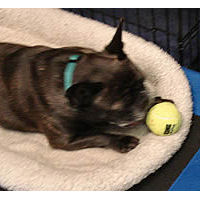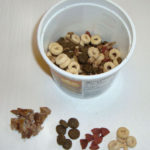Just like people, dogs have preferences.
There are “low value” and “high value” rewards. That goes for all types of rewards; food, toys, even attention.
For instance, Hope’s Torque has a very consistent hierarchy of toys:

- Squeaky rubber/plastic balls
- Non-squeaky rubber/plastic balls
- Tennis balls
- Rubber/plastic squeaky non-ball toys
- Non-squeaky, non-ball rubber/plastic toys
- Squeaky soft toys
- Non-squeaky soft toys
Drop it – maybe, maybe not!
So when Hope is working on “drop it,” which is extremely difficult for Torque, she can exchange a lower-value toy for a higher-value toy. But if she tries to go too far up the value scale, it’s not worth giving up the toy for anything Hope can offer.
There’s a treat value list for Torque, too:

- Hot dog pieces
- Cheese
- Freeze-dried Chicken Hearts or Turkey Gizzards
- Cheerios (Honey-Nut is his favorite)
- Kibble
Trade equal value rewards: toy for a treat
So Hope can trade a higher-value toy for a higher-value treat. But don’t try to swap a squeaky rubber ball for a piece of kibble – it’s not going to happen. Not yet. Maybe not ever.
Your dog has a reward hierarchy too
Do you know your dog’s reward value lists? If not, it’s worthwhile spending a few minutes to figure it out. It may shed some light on what’s working particularly well in your training, and the reasons why some things may not be working right now.
High value rewards should be used for high value behaviors
Keep the highest-value rewards as a special treat for your dog when he/she achieves something that’s been challenging. Keep in mind that we’re not using any of these as lures. We’re teaching our dogs to make good choices. And rewarding them for success.
